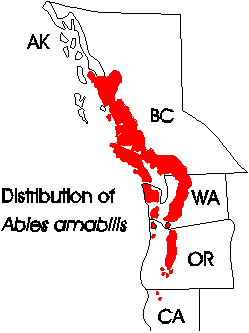
Drawing of the largest known Pacific silver fir, on Goodman Creek [Robert Van Pelt] (9).
Common Names
Pacific silver fir, white fir, red fir, lovely fir, amabilis fir, Cascades fir (3, 4), silver fir, sapin gracieux (7).
Taxonomic notes
Description
Trees to 24-46(75) m tall with 60-120 (260) cm dbh; straight, crown spirelike, with age becoming flat topped, cylindric. Bark light grey, smooth but for resin blisters, with age breaking into reddish-grey scaly plates. Branches diverging from trunk at right angles, short, stiff; twigs mostly opposite, darker brown abaxially, light brown adaxially, pubescence tan. Buds small, spherical, brown, globose, 6-9 mm diameter, with violet wax; basal scales short, broad, triangular, densely pubescent, usually not resinous, margins entire, apex sharp-pointed. Needles (0.7)1-2.5(4.0) cm × 1-3 mm, crowded, spreading forwards in 2 rows, overlapping above, nearly covering the branchlet, curved upwards on sun foliage, grooved and dark lustrous green above, somewhat flattened and silvery white with 5-6 stomatal rows on each side of midrib below, apex prominently notched; resin canals small, near margins and abaxial epidermal layer. Male cones at pollination red, becoming reddish yellow. Female cones erect, ovoid-cylindric, resinous, purplish then brown, 8-10(18) cm long × 3.5-5(7) cm, purple, sessile, apex round to nipple-shaped; scales ca. 2 × 2 cm, finely pubescent; bracts hidden, purplish, about 1/2 height of scale. Seeds 10-12 × 4 mm, body tan; wing about as long as body, rose to tan; cotyledons 4-7 (1, 5, 7).Range
US: SE Alaska, W Washington and Oregon, NW California; Canada: W British Columbia. Prefers deep, well-drained soils in cool, moist coastal forests, descending to sea level from Vancouver Island northwards, typically above 1000 m in Oregon and southwards, occurring to timberline (ca. 2300 m). Climate is maritime with long, snowy winters. (3). See also (10).Big Tree
Largest: Height 66.1 m, dbh 237 cm, crown spread 9.5 m, stem volume 97.2 m 3 in 1989; on Goodman Creek near Forks, WA (9).Tallest: Height 71.9 m, dbh 140 cm, crown spread 10.5 m in 1989; on the E Fork Humptulips River in Olympic National Forest, WA (9).
Oldest
The oldest confirmed age is 725 years for a specimen found by Ken Lertzman in Cypress Provincial Park, BC (9). Jan Henderson (pers. comm. 1990) reports ring counts of > 800yrs on repeatedly suppressed-and-released stumps in Baker-Snoqualmie NF.
Dendrochronology
Has been widely used, almost entirely in work done since 1980. Applications have included dendroclimatic reconstruction, ecosystem changes in old-growth montane and forest-tundra subalpine forests, dating and effects of volcanic debris flows, forest decline due to volcanic ash deposition, and impacts to tree growth from aluminum smelter emissions (8).
Ethnobotany
The pitch was chewed as gum by native peoples, the boughs were preferred for bedding or floor coverings, and the soft, brittle wood was chiefly used as firewood (3).It is an important timber species due to its wide distribution and potentially rapid growth; it is primarily a source of pulp.
Observations
Fairly common in the subalpine zone within its range, and easily seen in Olympic, North Cascades and Mount Rainier National Parks (WA).
Remarks
The species name means "lovely." This species is characteristic of the montane zone of western BC and the subalpine zone in western Washington and Oregon, where it may form mixed or monospecific stands and currently is widely distributed as advance regeneration beneath a canopy of similar species. It is among the most shade-tolerant of all conifers and can persist beneath a dense conifer canopy for centuries, an ecological situation that has characterized the oldest known specimens. It has reportedly retained needles for as long as 53 years, a record exceeded only by Welwitschia mirabilis , with needle retention times in excess of 20 years quite common.Species discovered and named by David Douglas, Scots botanist.
Citations
(1) Silba 1986 .(2) Packee et al. 1981 .
(3) Pojar and Mackinnon 1995 .
(4) Peattie 1950 .
(5) Little 1980 .
(6) American Forests 1996 .
(7) Richard S. Hunt at the Flora of North America web site .
(8) Search the Bibliography of Dendrochronology .
(9) Van Pelt 1996 .
(10) Robert S. Thompson, Katherine H. Anderson and Patrick J. Bartlein. 1999. Atlas of Relations Between Climatic Parameters and Distributions of Important Trees and Shrubs in North America. U.S. Geological Survey Professional Paper 1650 A&B. URL= http://greenwood.cr.usgs.gov/pub/ppapers/p1650-a/pages/conifers.html .
See also:
Burns & Honkala 1990
.
FEIS database
.
Vidakovic 1991
.
[ Abies ] [ Pinaceae ] [ home ]
This page is from the Gymnosperm Database
URL: http://www.geocities.com/RainForest/Canopy/2285/pi/ab/amabilis.htm
Edited by Christopher J. Earle
E-mail:
earlecj@earthlink.com
Last modified on 22-Jan-2000
